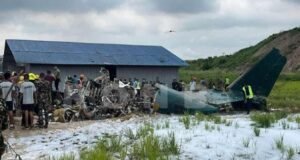
The Morocco-based Spanish activist said she alerted Spain’s maritime rescue service about the sinking dinghy and its approximate location and that 26 survivors, all from sub-Saharan African countries, were brought ashore 1½ days later in the northern Moroccan town of Nador.
A rescue service spokeswoman said the distressed boat was within Morocco’s jurisdictional waters and the Spanish agency repeatedly offered to help with a search-and-rescue operation, but received no response from Morocco.
“The dinghy was in an area very close to Morocco, not far from the beach,” said the spokeswoman, who was not authorized to be named in media reports.
The Interior Ministry said late Tuesday that Royal Gendarmerie officers found the bodies of 11 African migrants off Nador. A ministry statement said 31 others were rescued from the boat smuggling them.
An 18-year-old Malian who was among the rescued survivors was taken into custody after being identified as the person directing the dinghy the dinghy, the statement said. Moroccan authorities did not address Maleno’s allegation of a holdup in the rescue operation.
The U.N’s International Organization for Migration said it couldn’t independently confirm Maleno’s account. IOM spokesman Joel Millman said Walking Borders was a “reliable” source of information in the part of the world it serves.
Maleno said she came up with the possible death count of 32 adults and two children from survivor accounts, including from the mother of one of the children feared dead.
The activist blamed Spain and Morocco for responding slowly and with poor coordination, a recurrent problem that Walking Borders has highlighted amid a spike in the number of Europe-bound migrants departing from northern Africa.
“There was a lack of coordination to rescue them, and they were left to die slowly,” Maleno said. She described the survivors as being in deep shock.
“They have spent many hours watching people die and many hours in the water,” she added. “This is not the same as a fast-paced wreck; it has been a real torture for them.”
According to the International Organization for Migration, more than 36,600 migrants arrived in Spain by sea during the first nine months of the year, a jump in the number from previous years that has put a strain on public services.
During the same period, more than 360 migrants were reported to have died in the waters separating Spain from the African coast, doubling the figure from the first three quarters of 2017. More than 1,700 have died on the various Mediterranean Sea routes altogether.
Many of the migrants who attempt to cross the Straits of Gibraltar, where Africa is closest to the European mainland, carry the mobile phone number of Walking Borders so they can alert the aid group if they encounter trouble.
On Tuesday, Spanish rescuers found 423 migrants attempting the dangerous crossing in 10 different boats, the service said, including a dinghy carrying 21 people that was located 50 nautical miles north of the Canary Islands.
She described the survivors as being in deep shock.
“They have spent many hours watching people die and many hours in the water,” she added. “This is not the same as a fast-paced wreck; it has been a real torture for them.”
According to the International Organization for Migration, more than 36,600 migrants arrived in Spain by sea during the first nine months of the year, a jump in the number from previous years that has put a strain on public services.
During the same period, more than 360 migrants were reported to have died in the waters separating Spain from the African coast, doubling the figure from the first three quarters of 2017. More than 1,700 have died on the various Mediterranean Sea routes altogether.
Many of the migrants who attempt to cross the Straits of Gibraltar, where Africa is closest to the European mainland, carry the mobile phone number of Walking Borders so they can alert the aid group if they encounter trouble.
On Tuesday, Spanish rescuers found 423 migrants attempting the dangerous crossing in 10 different boats, the service said, including a dinghy carrying 21 people that was located 50 nautical miles north of the Canary Islands.
 Weekly Bangla Mirror | Bangla Mirror, Bangladeshi news in UK, bangla mirror news
Weekly Bangla Mirror | Bangla Mirror, Bangladeshi news in UK, bangla mirror news







